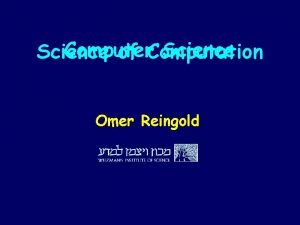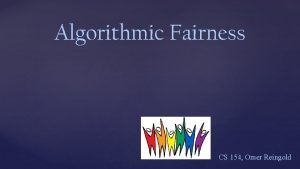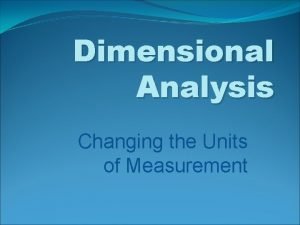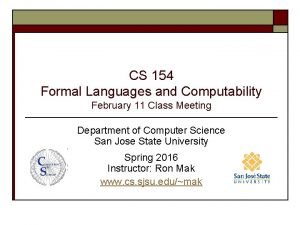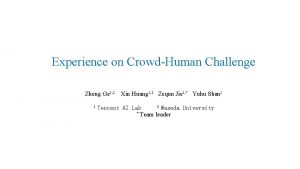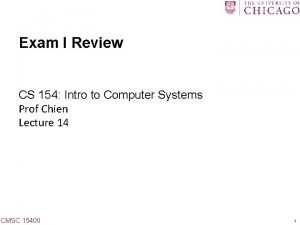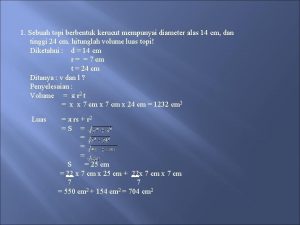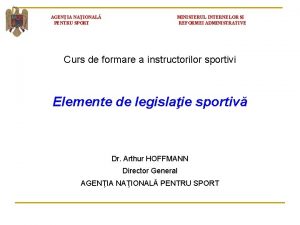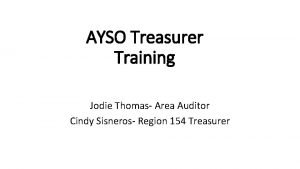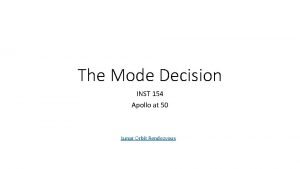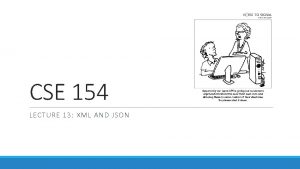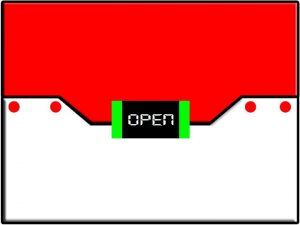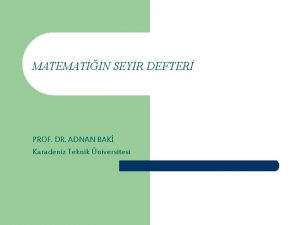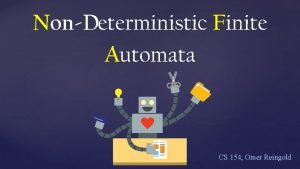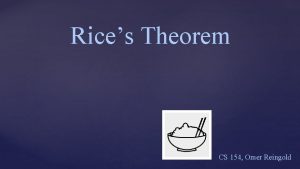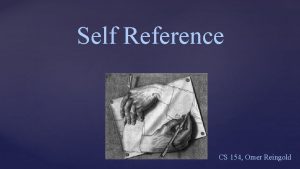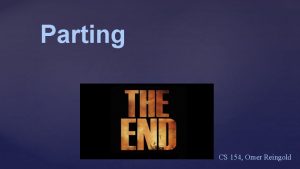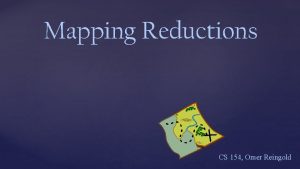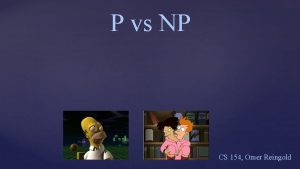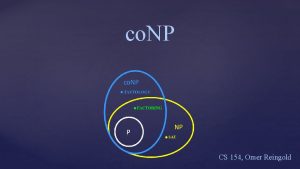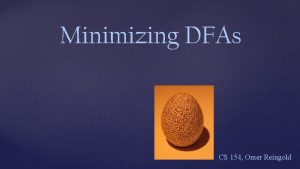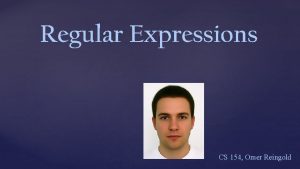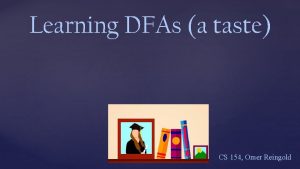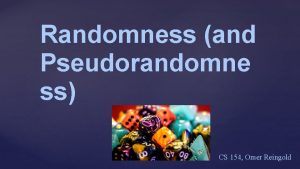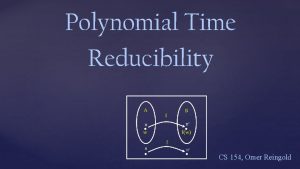Streaming Algorithms CS 154 Omer Reingold Streaming Algorithms



















- Slides: 19

Streaming Algorithms CS 154, Omer Reingold

Streaming Algorithms 01 Here: vague on computation cost (less of an issue for DFAs). All our examples – efficient computation 42

L = {x | x has more 1’s than 0’s} Initialize: C : = 0 and B : = 0 When the next symbol is read, If (C = 0) then B : = , C : = 1 If (C 0) and (B = ) then C : = C + 1 If (C 0) and (B ) then C : = C – 1 When the stream stops, accept if B=1 and C > 0, else reject B = the majority bit C = how many more times that B appears On all strings of length n, the algorithm uses (1+log 2 n) bits of space (to store B and C )

Streaming Algorithms 01011101 Streaming algorithms differ from DFAs in several significant ways: 1. Streaming algorithms can output more than one bit Can recognize non-regular languages 2. The “memory” or “space” of a streaming algorithm can (slowly) increase as it reads longer strings 3. Sometimes allow making multiple passes over the data; Could be randomized

DFAs and Streaming 01011101 Theorem: Suppose a language L can be recognized by a DFA M with ≤ 2 p states. Then L is computable by a streaming algorithm A using ≤ p bits of space.

DFAs and Streaming Theorem: Suppose L is computable by a streaming algorithm A using f(n) bits of space, on all strings of length up to n. for all n, there is a DFA M with ≤ 2 f(n) states such that L n = L(M) n Proof Idea: States of M = 2 f(n) possible settings of A’s memory, on strings of length up to n Start state of M = Initial memory configuration of A Transition function = Mimic how A updates its memory Accept states of M = Configurations in which A would accept, if string ended

Example: L = {x | x has more 1’s than 0’s} Initialize: C : = 0 and B : = 0 When the next symbol x is read, If (C = 0) then B : = x, C : = 1 If (C 0) and (B = x) then C : = C + 1 If (C 0) and (B x) then C : = C – 1 When the stream stops, accept if B=1 and C > 0, else reject 1 1 (0, 0) (B, C) (1, 1) 0 0 0 1 (1, 2) (0, 1) 0 0 1 (1, 0) (0, 2) 1 1 0

L = {x | x has more 1’s than 0’s} Is there a streaming algorithm for L using much less than (log 2 n) space? Theorem: Every streaming algorithm for L needs at least (log 2 n)-1 bits of space We will use: • Myhill-Nerode Theorem • The connection between DFAs and streaming

L = {x | x has more 1’s than 0’s} Theorem: Every streaming algorithm for L requires at least (log 2 n)-1 bits of space Proof Idea: Let n be even, and Ln = {0, 1}n L We will give a set Sn of n/2+1 strings such that each pair in Sn is distinguishable in Ln Myhill-Nerode Thm ⇒ Every DFA recognizing Ln needs at least n/2+1 states ⇒ Every streaming algorithm for L needs at least (log n)-1 bits of memory on strings of length n

L = {x | x has more 1’s than 0’s} Theorem: Every streaming algorithm for L requires at least (log 2 n)-1 bits of space Suppose we partition all strings into their equivalence classes under ≡Ln But the number of states in a DFA recognizing Ln is at least the number of equivalence classes under ≡Ln

L = {x | x has more 1’s than 0’s} Theorem: Every streaming algorithm for L requires at least (log 2 n)-1 bits of space Proof: Let Sn = {0 n/2 – i 1 i | i =0, …, n/2} Let x=0 n/2 – k 1 k and y=0 n/2 – j 1 j be from Sn, with k > j Claim: z = 0 k– 11 n/2–(k– 1) distinguishes x and y in Ln xz has n/2 -1 zeroes and n/2+1 ones ⇒ xz Ln yz has n/2+(k-j-1) zeroes and n/2 -(k-j-1) ones But k-j-1 ¸ 0 … so yz Ln So the string z distinguishes x and y, and x ≢Ln y

L = {x | x has more 1’s than 0’s} Theorem: Every streaming algorithm for L requires at least (log 2 n)-1 bits of space Proof: All pairs of strings in Sn are distinguishable in Ln ⇒ There at least |Sn| equiv classes of ≡Ln By the Myhill-Nerode Theorem: ⇒ All DFAs recognizing Ln need ¸ |Sn| states ⇒ Every streaming algorithm for L requires at least (log 2 |Sn|) bits of space. Recall |Sn|=n/2+1 and we’re done!

Finding Frequent Items A streaming algorithm for recognizing L = {x | x has more 1’s than 0’s} tells us if 1’s occur more frequently than 0’s. What if the alphabet is more than just 1’s and 0’s? And what if we want to find the “top 10” symbols? FREQUENT ITEMS: Given k and a string x = x 1 xn Σn, output the set S = {σ Σ | σ occurs > n/k times in x} (How large can the set S be? )

FREQUENT ITEMS: Given k and a string x = x 1 xn Σn, output the set S = {σ Σ | σ occurs > n/k times in x} Theorem: There is a two-pass streaming algorithm for FREQUENT ITEMS using O(k (log |Σ| + log n)) space. 1 st pass: Initialize an set T ⊆ Σ x ℕ (originally empty) Read the next symbol σ from the stream. If (σ, m) T, then T : = T – {(σ, m)} + {(σ, m+1)} Else if |T| < k-1 then T : = T + {(σ, 1)} Else for all (σ’, m’) T, T : = T – {(σ’, m’)} + {(σ’, m’-1)} If m’ = 0 then T : = T – {(σ’, m’)} Claim: T contains all σ occurring > n/k times in x 2 nd pass: Count occurrences of all σ’ appearing in T to determine those occurring > n/k times

Number of Distinct Elements The DE problem Input: x {0, 1, …, 2 k}*, 2 k > |x|2 Output: The number of distinct elements appearing in x Note: There is a streaming algorithm for DE using O(k n) space Theorem: Every streaming algorithm for DE requires (k n) space 15

Theorem: Every streaming algorithm for DE requires (k n) space Let Σ = {0, 1, …, 2 k} Define: x, y 2 Σ* are DE distinguishable if (9 z 2 Σ*)[xz and yz contain a different number of distinct elements] Lemma: Let S µ Σ* be such that every pair in S is DE distinguishable. Then every streaming algorithm for DE needs ¸ (log 2 |S|) bits of space. Proof: Pigeonhole Principle! If an algorithm A uses < (log 2 |S|) bits, there are distinct x, y in S that lead A to the same memory state. Consider xz and yz … 16

Theorem: Every streaming algorithm for DE requires (k n) space Lemma: Let S µ Σ* be such that every pair in S is DE distinguishable. Then every streaming algorithm for DE needs ¸ (log 2 |S|) bits of space. Lemma: There is a DE distinguishable S of size 2 (k n) Proof: For each subset T of Σ of size n/2, define x. T to be any concatenation of the strings in T For distinct sets T and T’, x. T and x. T’ are distinguishable: x. T contains exactly n/2 distinct elements x. T’ x. T has more than n/2 distinct elements The total number of such subsets is 2 (k n), for 2 k > n 2.

Randomized Algorithms Help! The DE problem Input: x {0, 1, …, 2 k}*, 2 k > |x|2 Output: The number of distinct elements appearing in x Theorem: There is a randomized streaming algorithm that can approximate DE to within 0. 1% error, using O(k + log n) space! Suppose: the elements are selected uniformly at random. What can we say about the minimal element? If we have at our disposal a random permutation h over {0, 1, …, 2 k} what can we do? Derandomizatrion: h that is efficient and have short description.

Parting thought: Streaming – modern day incarnations of DFAs Randomness – could be a useful resource of computation (I)
 Omer reingold
Omer reingold Omer reingold
Omer reingold A person's weight is 154 pounds convert this to kilograms
A person's weight is 154 pounds convert this to kilograms Homework 154
Homework 154 Cs 154 sjsu
Cs 154 sjsu Crowdhuman
Crowdhuman Cs 154 uchicago
Cs 154 uchicago Inst154
Inst154 Anastasiya vitko stanford
Anastasiya vitko stanford Al baqarah 154-157
Al baqarah 154-157 Cr part 154
Cr part 154 Cse 154
Cse 154 Sebuah topi berbentuk kerucut di
Sebuah topi berbentuk kerucut di Ordinul 154 din 2004
Ordinul 154 din 2004 Nap online ayso
Nap online ayso Lunar landing mission
Lunar landing mission Cse 154
Cse 154 Dodo akan memberi kado ulang tahun buat desi
Dodo akan memberi kado ulang tahun buat desi Data system
Data system ömer hayyam ın yaptığı çalışmalar
ömer hayyam ın yaptığı çalışmalar
